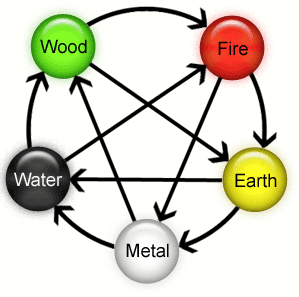The Five Elements
Five Element theory probably originated in China around 500 BC. It provides us with a broad conceptual model with which we can describe and interpret our world.
| Season | Environment | Yin Organ | Yang Organ | Direction | Taste | Sense Organ | Body Tissue | Emotion | |
|---|---|---|---|---|---|---|---|---|---|
| Metal | Autumn | Dry | Lung | Large Intestine | West | Pungent | Nose | Skin, Body Hair | Grief |
| Water | Winter | Cold | Kidney | Bladder | North | Salty | Ears | Bones, Nails | Fear |
| Wood | Spring | Wind | Liver | Gall Bladder | East | Sour | Eyes | Tendons | Anger |
| Fire | Summer | Heat | Heart | Small Intestine | South | Bitter | Tongue | Vessels | Joy |
| Earth | Late Summer | Damp | Spleen | Stomach | Centre | Sweet | Eyes | Muscles | Anxiety |
More specifically, the theory describes cyclical relationships between phenomena or objects according to the properties that each phenomenon or object displays. The Five Elements are symbolic representations of movements, phenomena or objects and can be applied macrocosmically to the universe, or microcosmically to an individual. The Elements describe everything in terms of the cycle between Metal, Water, Wood, Fire and Earth. Each of these elements has correspondences to seasons, sounds, emotions, body tissue, organs and so on (as shown in the correspondence table). The cycles

The Five Elements also relate to each other in terms of cycles or phases. In a balanced environment, there are two cycles that work harmoniously.
The creation cycle
This is shown in the diagram by the arrows forming a circle through the elements. The creation cycle says that Metal creates Water which creates Wood which creates Fire which creates Earth which creates Metal. Various metaphors exist to explain this cycle (for example water droplets can form on a metal surface so we can say Metal creates Water in the form of condensation, Water is necessary for trees to grow thus it creates Wood, Wood is burned to create Fire and so creates ash which becomes Earth from which we mine Metal). Another way to think about the creation cycle is in terms of movement — as each movement exhausts its potential, it must transform into a different movement to avoid stagnation.
The controlling cycle
The controlling cycle exists to ensure that no element gets out of hand (in the diagram, this is shown by the crisscrossing arrows inside the circle). So Metal controls Wood, Wood controls Earth, Earth controls Water, Water controls Fire and Fire controls Metal. Again metaphors exist to explain this (a Metal axe chops trees or Wood, the roots of the trees or Wood bind the Earth, the Earth contains and controls lakes or Water, Water quenches Fire which is used to help shape Metal).